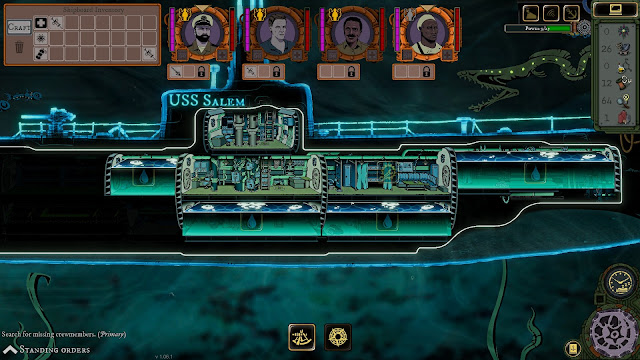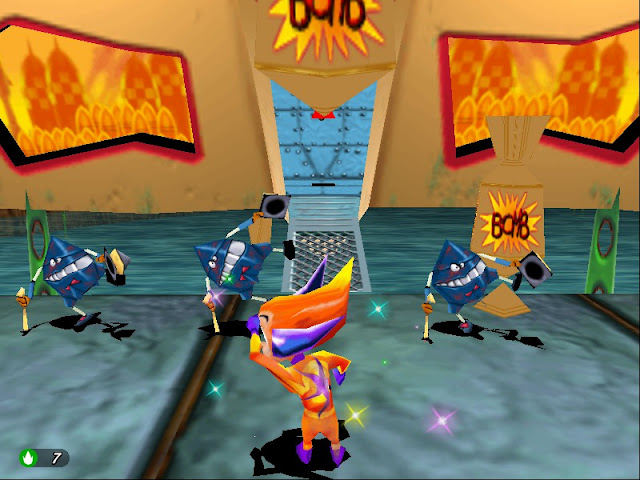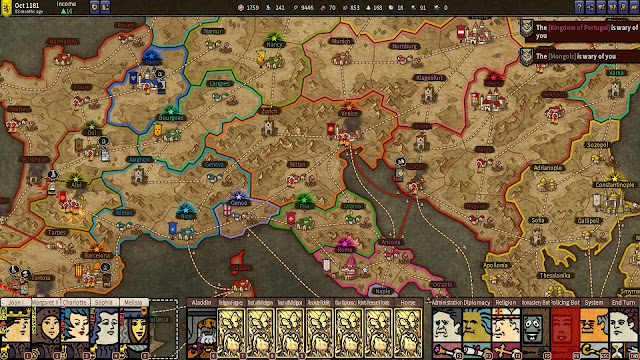Stirring Abyss Review | Terror in the deep
Lovecraftian myths have exploded in popularity in recent years, definitely thanks to the interesting modern setting and being a relatively recent release still ingrained in the public's mental gestalt, plus the fact that these books may have entered the public domain could be a factor too (but this one is still being disputed, so don't quote me on that).
Many have taken inspiration from his works and decided to make their one original creations and one of these is Stirring Abyss.
Aesthetics
 |
The base of a temple in the depths of the ocean, seems abandoned ... seems |
The graphics used are mainly 2d drawn images, with 3d models dedicated to divers. The style used is good for the environments, but looks a bit flat for the drawings of the enemies, it doesn't stick out and makes them look a bit bland, but what works really well is the heavy usage of the dark in most of the screen, giving the ambiance a great feeling of confusion and eeriness.
The particle details are competently used, put here and there to emphasize the theme of being on the bottom of the sea, like when someone gets hurt the blood stays in midair or the almost constant presence of small bubbles of air.
The animations are a bit choppy, they are not the smoothest, but considering the turn based nature of the game I can't really complain.
Apart the initial and final movies, there isn't any voice acting, at best you hear the sounds of your crewmates as they get hurt or suffer psychological damage.
On the other hand, the soundtrack is creepy, as it should, it manages to convey a sense of mystery and dangers unseen just beyond the darkness.
The various sounds are more or less on the same page.
In short, the game has a good art direction, but not the greatest animations or voice acting.
Game Mechanics
 |
Take care of the submarine, it's your safe haven and best ally |
The title is a turn based strategy game on a semi-checkerboard with strong role playing elements, a little side of base building and some procedural generations for the levels and characters.
The crewmates have 4 main stats: agility(influences critical strike chance and aim for melee attacks), insight(influences aim for ranged attacks and the maximum sanity), strength(influences health and base melee damage) and endurance(influences damage reduction and defense).
In addition, they also have 3 bars: health, sanity and air.
Sanity is the less obvious one, when it runs out the crewmate goes temporary insane and may attack friendly units, after going back to normal the maximum sanity of the crewmate will be reduced, if the maximum sanity goes to 0 they become completely insane and as such unusable. Each one also has a class which determines the ability that it is capable to perform, of the 3 classes: one focuses on melee attacks, another on causing various debuffs and the last one on ranged attacks.
Not many, but varied enough to feel distinct and have their one use cases here and there.
Each character can level up and raise the personal statistics and gain a new ability/trait either passive or active, there are also some magic powers that have situational but crucial usages, such as the ability to teleport one of your divers for a short distance.
Beyond the characters, the submarine is your main base and the place where you make the most important decisions.
In here you can repair sections to allow new features to be unlocked, rest at the cost of a rising corruption, craft items, choose a mission, modify parts of the ship to have new effects or upgrade the already available ones and spend clues for bonuses applicable to the whole crew.
Very varied amount of systems, even if they may not be the deepest.
There are various objects that represent the economy of the game, which can be grouped together in 4 main categories: various gatherable materials, energy for the ship, clues and void marrow.
The materials are used for crafting items and fixing the sections of the ship, the energy is used to pump the water out from these sections(necessary step before the repairs can be executed) or used for one of the abilities of the submarine (like using the lights to reveal a part of the map), clues are like experience points and unlock bonuses applicable for the entire crew and lastly void marrow is used to give mutations to the crew.
These mutations are actually a unique aspect of the game.
When you decide to mutate a character, you can choose between 2 (3 with an upgrade) mutations and the chosen one is going to add an ability, either passive or active, to a diver, and these abilities are very useful, granting a wide variety of bonuses, like the ability to give a diver gills that generate oxygen for them and the nearby allies.
Give mutations with care, the cost to add another one increases slowly but constantly.
Another important aspect is the corruption level, the more it grows, the more dangers you are going to face during your journey, it increases when you stay for too long in a level, when you make rest your crew in the submarine or when you fail specifics rolls.
About the rolls, sometimes you encounter objects of interest, signed by a question mark, that start a mini-game where a set of dices gets rolled, the dices have positive, neutral and negative sides that add up to a number and if the number is reached, a positive outcome is performed, otherwise a negative one occurs.
Keep in mind that the traits of the character that interacts with an object of interest can influence the outcome of the dices, both in good and bad ways.
The mission are divided in 2 categories: primary and secondary, the primary missions are the ones related to the story and continue the narrative, while the secondary one can deliver many optional bonuses. To unlock the secondary missions, you need to spend 3 points of energy in the submarine. These missions vary from search and rescue of lost crew, retrieval of supplies or defense of altars that can reduce the level of corruption, plus there is a small series of missions that unlock an alternative ending later in the adventure.
I think the quest design is varied enough to satisfy every need you may encounter, both resource and gameplay wise.
The saving system is very permissive, you can save almost everywhere and you can access all your saves in the main menu.
There is a bit of procedural generations in game, most notable in the levels, very few have a defined layout.
The missions are generated only once, meaning that if you fail it, the level remains the same on another attempt, but if you start a new run entirely, the same mission is going to have a different layout.
The procedural generation is applied to the characters as well in a less drastic way, meaning they mainly change in appearance, starting traits and abilities, while the classes stay the same.
The enemies are a good variety of threats, each one with their one specialization and focus, like some tend to do more damage to the sanity bar rather than the health one.
The Artificial Intelligence is fine too, it seemed to use the enemies at its advantage in a competent way.
There are 4 difficulties: narrative, easy, normal and hard.
I tried a small run on easy, but I gave up almost immediately, I am a total scrub at turn based games, I lack the patience to learn the mechanics with care and I get easily frustrated, especially when I feel like the RNG just wanted to screw with me making every shot from my characters miss and letting every hit from the enemies being a critical one.
A difference seems on the availability of the endless mode, where you face an increasingly difficult set of levels forever, but if you fail 3 times it's game over.
Endless mode is only available on easy difficulty or harder.
While it may not be everybody's favorite idea, I appreciated the fact that the developers added the difficulty selection for this particular game.
Including my failed run, it took me 8 hours to beat the game.
Summarizing, there are a lot of good elements that work nicely with the overall themes, even if I am too much of a wimp to appreciate them fully.
Narrative
 |
Dialogue boxes like this is how the story is told for most of the game |
In 1958, the submarine USS Salem encountered an unidentified entity, which caused the ship and its crew to sink in the middle of the ocean. Dispersed and lost, one member of the crew must find the other ones plus the submarine, but he must be vigilant, there are strange creatures in the depths.
While a bit on the nose, the incipit sets the stage for what's to come in a good way, messed up stuff doesn't take too much time to show itself.
Operas inspired by Lovecraft myths must always deliver a sense dread and thanks to the work on the visual and gameplay department the game manages to. The encounters and revelations are creepy, but their origin is kept vague to keep the unknown eldritch feel constantly during the whole adventure.
Look around very carefully, you can experience a secondary story about a previous soviet expedition, if you manage to find most of the audio logs you can reconstruct what happened to them and also find hints for a potential alternative ending.
Due to the procedural generation of the game, there isn't any kind of characterization for the characters or quirky personality features to make them unique.
Like you could expect for such a premise, myths and legends are few and far between, even the present ones don't deliver many answers, just more material to speculate on, as it should be.
In conclusion, the narrative is interesting and creepy enough, even if it may not be the most original or refined due to the lack of personality in the characters.
Recommendation:
Stirring Abyss is an experience I recommend if you want to scratch that eldritch horror itch, but can't bring yourself to bear to play an actual horror game.




Comments
Post a Comment